I cross posted that last post with you. On Pyrex, it fails violently, exploding little pieces in all directions as it releases build up tension/compression. I found that out the hard way, which is kinda fun.
As for temps, man, 700+ on the barrel face is HOT! I pretty much never get there, unless I'm really trying. Average running temp on the indoor system is around 450-500 on the face. Frankly, I think you are on to something good. You are getting so hot on the barrel because the heat has nowhere else to go. I think that is a very good thing. The downside is when you lose your burn, i.e. walk away for too long, you'll have to light it again. But, that's what the mass is for, which you are going to charge quickly with that type of system.
As for start up, I'm smokeless and full temp after 5-10 minutes max with good fuel. I also cool quickly, although you're probably another level up from there, insulation wise. I think if I were you, I'd gladly accept just an inch or so of dense hot face for durability and a very small flywheel. It would still be hyper insulated, but I imagine that hot face riding near two thousand degrees would go a long ways to help completely burn any little bits hanging around once most of the fuel was gone.
BOOH V
Moderator: matt walker
42 posts
• Page 3 of 5 • 1, 2, 3, 4, 5
Re: BOOH V
Okay, all very helpful info. However, before reading your last post, I went out and ran another test including a pyrex pot. Let me gloat just a bit about how cool it is to have a system that I can move around and fire up in about as much time as it takes to write it. This time I set up at a step so that it was easier to see what was going on.

Unfortunately, the larger pot which would have made a better plug was broken by freezing water since the last time I looked at it. On the plus side, you can peek past this one. Plus until it blows up.

Unfortunately, the larger pot which would have made a better plug was broken by freezing water since the last time I looked at it. On the plus side, you can peek past this one. Plus until it blows up.
Mark
(aka Nutcase)
(aka Nutcase)
- Nutcase
- Posts: 145
- Joined: Fri Dec 21, 2012 10:35 pm
- Location: NW Oregon
Re: BOOH V
Here is the system as it is revving up. Faster than last time, smoke declining sharply at about 4 min, about 8 min to 500˚. However, it continued to smoke a bit intermittently, even at higher temps.

It's hard to capture in the photos, but you can see flames being quenched when they hit the roof and turning into streams of smoke at this stage.

It's hard to capture in the photos, but you can see flames being quenched when they hit the roof and turning into streams of smoke at this stage.
Mark
(aka Nutcase)
(aka Nutcase)
- Nutcase
- Posts: 145
- Joined: Fri Dec 21, 2012 10:35 pm
- Location: NW Oregon
Re: BOOH V
So, after pushing the wood further in and throwing in another piece, a I stuck the pot in.
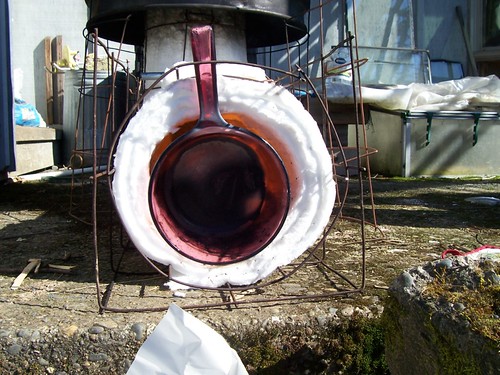
in this photo you can see patches where the teflon is burning off. Max temp this time was 770˚. The handle remained cool. I came back inside when the temp drifted back down to 500˚.
Gotta go do other things. I'll have some more comments and questions later.

in this photo you can see patches where the teflon is burning off. Max temp this time was 770˚. The handle remained cool. I came back inside when the temp drifted back down to 500˚.
Gotta go do other things. I'll have some more comments and questions later.
Mark
(aka Nutcase)
(aka Nutcase)
- Nutcase
- Posts: 145
- Joined: Fri Dec 21, 2012 10:35 pm
- Location: NW Oregon
Re: BOOH V
Here's the pot after the cool-down:
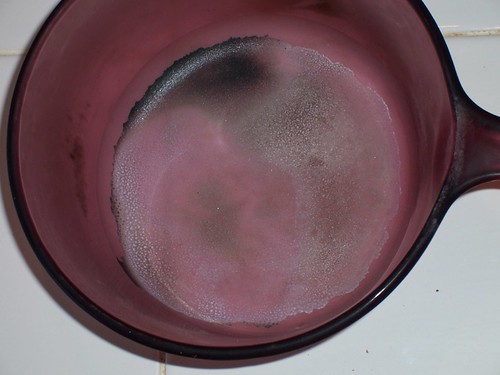
My wife has vetoed further experiments with it as an endcap. Even after I told her it would probably mostly throw glass splinters into the burn chamber if it ever exploded, so the risk was really not that great...
Anyway, for today I wanted to look into the effect of adding significant thermal mass to the inside of the burn chamber. I also wanted to see what happens to aluminum and whether it has a noticeable affect on the blanket. Finally, I wanted to take another look at what I had described as "quenching" when flames met the ceiling.
So I stuck this thing in:
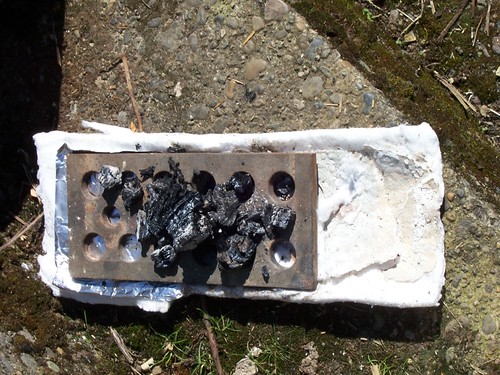
It's a cast iron piece from a sauna heater, weighs in at close to 4 lbs, resting on the refractory cement "tray". This piece is getting pretty beaten up, but it still serves as a buffer for the grate. I've also folded over the end and stuck in a piece of aluminum foil. There might be some value in the foil as a barrier to air flow and radiation. The easy way to incorporate it would be to just lay a layer on the blanket before I roll it into a tube, and let it burn off where it burns off. If it doesn't damage the blanket in the process. I don't expect a problem like that, but why not check?

My wife has vetoed further experiments with it as an endcap. Even after I told her it would probably mostly throw glass splinters into the burn chamber if it ever exploded, so the risk was really not that great...
Anyway, for today I wanted to look into the effect of adding significant thermal mass to the inside of the burn chamber. I also wanted to see what happens to aluminum and whether it has a noticeable affect on the blanket. Finally, I wanted to take another look at what I had described as "quenching" when flames met the ceiling.
So I stuck this thing in:

It's a cast iron piece from a sauna heater, weighs in at close to 4 lbs, resting on the refractory cement "tray". This piece is getting pretty beaten up, but it still serves as a buffer for the grate. I've also folded over the end and stuck in a piece of aluminum foil. There might be some value in the foil as a barrier to air flow and radiation. The easy way to incorporate it would be to just lay a layer on the blanket before I roll it into a tube, and let it burn off where it burns off. If it doesn't damage the blanket in the process. I don't expect a problem like that, but why not check?
Last edited by Nutcase on Tue Mar 12, 2013 11:10 pm, edited 1 time in total.
Mark
(aka Nutcase)
(aka Nutcase)
- Nutcase
- Posts: 145
- Joined: Fri Dec 21, 2012 10:35 pm
- Location: NW Oregon
Re: BOOH V
The burn had its ups and downs. The details aren't of much interest. The bottom line is that it wasn't appreciably slower to get to high temperatures—any effect of the cast iron was overshadowed by how the sticks were arranged before reaching the blazing inferno stage. The fire remained intermittently smoky up to at least 500˚.
The phenomenon that I had characterized in an earlier post as "quenching" when the flames reached the ceiling is probably more along the lines of "suffocating." That is to say, mixing slows, so the flame runs out of air, and black body radiation from the soot particles then robs it of sufficient heat. I would have to do set up for video and control the geometry to really show this clearly, but that's what it looks like to me. When the overall flame density is higher, the conditions for maintaining combustion are better.
All else equal, the barrel top heats up more when the burn is moved further in. In part I think this reflects increased radiation to the barrel and less going out the fuel port. If this is so, then just putting a good IR reflector on the end, once the fuel isn't sticking out, should help keep the chamber hot, even if the reflector is held some distance out. The same would apply to the heat riser—an IR reflector inside the barrel top should keep more heat in the riser. Hmmm... not so easy.
The phenomenon that I had characterized in an earlier post as "quenching" when the flames reached the ceiling is probably more along the lines of "suffocating." That is to say, mixing slows, so the flame runs out of air, and black body radiation from the soot particles then robs it of sufficient heat. I would have to do set up for video and control the geometry to really show this clearly, but that's what it looks like to me. When the overall flame density is higher, the conditions for maintaining combustion are better.
All else equal, the barrel top heats up more when the burn is moved further in. In part I think this reflects increased radiation to the barrel and less going out the fuel port. If this is so, then just putting a good IR reflector on the end, once the fuel isn't sticking out, should help keep the chamber hot, even if the reflector is held some distance out. The same would apply to the heat riser—an IR reflector inside the barrel top should keep more heat in the riser. Hmmm... not so easy.
Mark
(aka Nutcase)
(aka Nutcase)
- Nutcase
- Posts: 145
- Joined: Fri Dec 21, 2012 10:35 pm
- Location: NW Oregon
Re: BOOH V
After the cooldown, the cast iron looked pretty much unaffected, except that dust had been burnt off. Well over an hour after the rest of the system was cool, it was still too hot to handle bare-handed. The aluminium foil, on the other hand, had pretty much burnt off, leaving a very thin filmy layer.
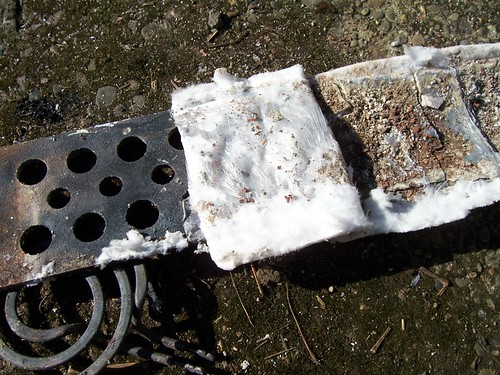
Some of the vitrified mortar has stuck to the cast iron, taking some blanket material with it.
Anyway, right now I don't see a problem with using this piece as a grate, if I can support it properly. A similar mass on the ceiling would be a different proposition.
Next I will have to cap the end and set up a vertical feed.

Some of the vitrified mortar has stuck to the cast iron, taking some blanket material with it.
Anyway, right now I don't see a problem with using this piece as a grate, if I can support it properly. A similar mass on the ceiling would be a different proposition.
Next I will have to cap the end and set up a vertical feed.
Mark
(aka Nutcase)
(aka Nutcase)
- Nutcase
- Posts: 145
- Joined: Fri Dec 21, 2012 10:35 pm
- Location: NW Oregon
Re: BOOH V
So today I installed the vertical fuel port:
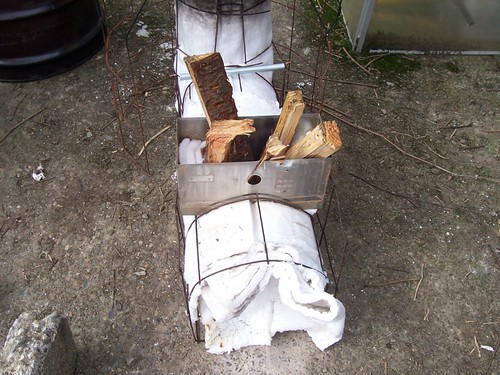
The stainless box is another piece scavenged from the sauna heater, 6"x12" opening, 6" tall. Fits conveniently in a hole made in the mesh cylinder by removing a single longitudinal wire segment. This left a 5"
deep dead end, capped off crudely with some material from a previous build.
The connection to the chimney is crappy. The combination of air leaks and narrowing at this transition can't be good.Of course I have ideas for fixes, but what the heck. The match is already lit.

The stainless box is another piece scavenged from the sauna heater, 6"x12" opening, 6" tall. Fits conveniently in a hole made in the mesh cylinder by removing a single longitudinal wire segment. This left a 5"
deep dead end, capped off crudely with some material from a previous build.
The connection to the chimney is crappy. The combination of air leaks and narrowing at this transition can't be good.Of course I have ideas for fixes, but what the heck. The match is already lit.
Mark
(aka Nutcase)
(aka Nutcase)
- Nutcase
- Posts: 145
- Joined: Fri Dec 21, 2012 10:35 pm
- Location: NW Oregon
Re: BOOH V
The first problem was that the inlet makes a nice chimney. Persuading the fire to go into the burn chamber was not so easy, especially as the fire rapidly ran up all of the sticks. Next time I will get it going sideways before I put in stuff this long.

Eventually I got the fire turned. The barrel top temp rose rapidly and plateaued around 580˚. The barrel remained intermittently smoky, and there was quite a bit of smoke escape from the inlet. My wife noted that the hole in the back of the inlet wasn't helping in this regard. She also thought that the dead end behind the fire was problematic. Covering the hole did incrementally improve the draw. partially covering the top of the inlet helped too. She put in one more piece of wood and the temp headed up 800˚. It's clear that we could push it further easily—lots of free space in the inlet channel—but what's the point.
Changing the inlet geometry to eliminate the dead end, make it narrower and covering that hole will be easy. I think I can significantly improve the burn channel/heat riser transition too. I will also see what happens with a shroud over the inlet. I've got the carcass of an old smoker that is the right size. After that, the next step will involve putting some sort of coating on the blanket and/or changing the system cross section to letterbox as a compromise between the ease of making turns/connections with square and the efficiency with material of circular.

Eventually I got the fire turned. The barrel top temp rose rapidly and plateaued around 580˚. The barrel remained intermittently smoky, and there was quite a bit of smoke escape from the inlet. My wife noted that the hole in the back of the inlet wasn't helping in this regard. She also thought that the dead end behind the fire was problematic. Covering the hole did incrementally improve the draw. partially covering the top of the inlet helped too. She put in one more piece of wood and the temp headed up 800˚. It's clear that we could push it further easily—lots of free space in the inlet channel—but what's the point.
Changing the inlet geometry to eliminate the dead end, make it narrower and covering that hole will be easy. I think I can significantly improve the burn channel/heat riser transition too. I will also see what happens with a shroud over the inlet. I've got the carcass of an old smoker that is the right size. After that, the next step will involve putting some sort of coating on the blanket and/or changing the system cross section to letterbox as a compromise between the ease of making turns/connections with square and the efficiency with material of circular.
Mark
(aka Nutcase)
(aka Nutcase)
- Nutcase
- Posts: 145
- Joined: Fri Dec 21, 2012 10:35 pm
- Location: NW Oregon
Re: BOOH V
I ran it again last evening, after doing some of the easiest things, i.e, improving the burn channel to heat riser connection and cutting off the dead end. I also just deleted the stainless steel inlet box. I didn't put long pieces in until the fire was already going sideways. It ramped up nicely to the high 500's again, still had intermittent smoke even at pretty high temps in the early going, but eventually that stopped. Still had some smokeback at the inlet. After the first wood was burning down, I put in some small stuff, mainly ash twigs, along with a couple larger pieces, and ran it up to 800˚+.
This system, like the other BOOHs, runs hot in part because it is possible to get a lot of surface area into the burn zone because of the inlet geometry. A stick going in at 45˚ or more has that much more length in the zone at one time compared to a stick going in vertically. Using many twigs instead of a few large pieces has the same effect.
The raw blanket as a flame contact surface is less than ideal, particularly during startup. I don't understand all of the physics, but my impression is that it soaks up IR. The blanket doesn't approximate a black body at the relevant temperatures. There are a number of interesting YouTube videos that show how coating a blanket lining a furnace with something like satanite or mizzou causes the inside of the furnace to glow more intensely with the same heat input from a torch. The gasses aren't hotter, but the surfaces are radiating the heat, and this will transfer heat to the colder parts—like a crucible or a chunk of metal—more efficiently.
I ran into something on a forge thread about how you can actually soak the ceramic blanket in a mizzou slurry, then form and dry it. This is like something you suggested doing with fireclay, Matt. I haven't ordered the bag of mizzou from High-Temp yet, but I should still be able to pick it up this week.
Meanwhile, I'm going to put a shroud over the air/fuel inlet, more or less as we discussed on your outside air thread. After that, I think I'll run a piece of pipe through the back of the heat riser and up along the bottom of the burn chamber and see what injecting some preheated air into the burn zone does.
This system, like the other BOOHs, runs hot in part because it is possible to get a lot of surface area into the burn zone because of the inlet geometry. A stick going in at 45˚ or more has that much more length in the zone at one time compared to a stick going in vertically. Using many twigs instead of a few large pieces has the same effect.
The raw blanket as a flame contact surface is less than ideal, particularly during startup. I don't understand all of the physics, but my impression is that it soaks up IR. The blanket doesn't approximate a black body at the relevant temperatures. There are a number of interesting YouTube videos that show how coating a blanket lining a furnace with something like satanite or mizzou causes the inside of the furnace to glow more intensely with the same heat input from a torch. The gasses aren't hotter, but the surfaces are radiating the heat, and this will transfer heat to the colder parts—like a crucible or a chunk of metal—more efficiently.
I ran into something on a forge thread about how you can actually soak the ceramic blanket in a mizzou slurry, then form and dry it. This is like something you suggested doing with fireclay, Matt. I haven't ordered the bag of mizzou from High-Temp yet, but I should still be able to pick it up this week.
Meanwhile, I'm going to put a shroud over the air/fuel inlet, more or less as we discussed on your outside air thread. After that, I think I'll run a piece of pipe through the back of the heat riser and up along the bottom of the burn chamber and see what injecting some preheated air into the burn zone does.
Mark
(aka Nutcase)
(aka Nutcase)
- Nutcase
- Posts: 145
- Joined: Fri Dec 21, 2012 10:35 pm
- Location: NW Oregon
42 posts
• Page 3 of 5 • 1, 2, 3, 4, 5
Who is online
Users browsing this forum: Google [Bot] and 7 guests
